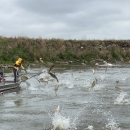Species that are considered uncertain risk need a more in-depth assessment beyond the Risk Summary to better define the species’ risk to U.S. environments.
Bostrychus sinensis is a tropical sleeper goby native to the Indo-Pacific region including Australia and southeastern Asia. It primarily occurs in coastal freshwater, estuarine, and coastal marine habitats and is commonly found in muddy mangroves. Its native distribution suggests a broad salinity tolerance. However, specific environmental parameters are not well documented in the literature. Although several sources indicate the species may have been introduced beyond its native range in Viet Nam and China for aquaculture purposes, no known nonnative populations were identified and thus there is no information on impacts from introductions. Therefore the history of invasiveness is classified as No Known Nonnative Population. The overall climate match for the contiguous United States was Medium. Climate match was highest along the southeastern Atlantic coast and Gulf of Mexico. Given the lack of climate match source points verified as freshwater observations and the paucity of environmental reproductive requirements for this species, it is uncertain if B. sinensis could establish a population in the strictly freshwater interior portions of the United States where the climate match was high (e.g., Oklahoma). The certainty of assessment is Low due to a general lack of information. The overall risk assessment category is Uncertain.



